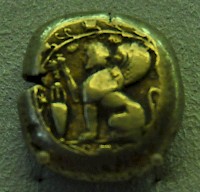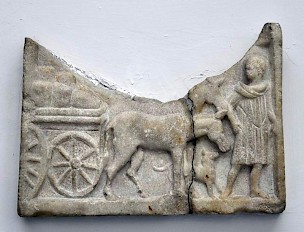Chios
Q748832Chios (Greek: Χίος): great island in the Aegean Sea.

Situated along the trade routes in the eastern part of the Aegean Sea, only seven kilometers from the Asian shore, and producing a famous wine and mastic gum, Chios had a reputation for wealth.note This large island had already been occupied since the Neolithic age and was also known as Pityoussa (Πιτυούσσα, “island of the pine trees”) and Ophioussa (Οφιούσσα, “island of the serpents”).
According to later Greek myths, the island was settled by Ionian immigrants arriving from the Greek mainland.note If there is any truth to this, it must have happened in about 1000 BCE. Linguistically, the island was Ionic,note but there were Aeolic influences and this “mix” of dialects may be one reason why people later believed that Homer was from Chios.
Pottery from Euboea and Cyprus documents that Chios was an important trade center as early as the ninth century BCE. Its main trade rival was Erythrae, on the opposite shore; the rivalry could escalate to war.note Chios' eastern port, also known as Chios, was the main trade center and one of the first Greek cities to strike coins.

Herodotus tells us that Chios was one of the twelve members of the Ionian Leaguenote and contributed to the construction of a Ionian temple in Naucratis.note After the Persians had conquered Lydia, an event traditionally dated to 547 BCE, Chios became part of the Achaemenid Empire too. It must have been a valuable addition to the Persian realms, because Chios was really powerful. When the Asian Greeks revolted against their new overlords (499-494), Chios contributed no less to than a hundred war ships to the navy.note
After the Persian Wars, Chios was one of the members of the Delian League (the Athenian alliance) and was one of the few members that did not pay tribute but maintained a fleet of its own. Although it remained loyal to Athens throughout the Archidamian War (431-421), Chios abandoned its ally during the Decelean War (413-404) and supported those Greeks who revolted. Later, it became a member of the Second Delian League, created in 378 BCE, but abandoned the Athenian alliance again during the Social War of 357-355. Later, we find it as part of the territories of Maussolus, the satrap of Caria, and Alexander the Great.

In the Hellenistic age, Chios became one of the largest producers of wine in the ancient world. Amphoras have been found all over the Mediterranean, as far as southern France and northern Egypt.
In the Syrian War (192-188) between the Seleucid Empire and the Roman Republic, Chios sided with Rome. This meant the end of its policy of trying to maintain its autonomy by switching alliances, because under Roman rule, there were no alternatives. This was a tranquil age and Chios benefited by starting to export natural stone, a curious breccia now called portasanta marble. There was no real break in Chian history when the eastern parts of the Roman Empire transformed into the Byzantine Empire.
Christianity is documented since the third century. In Phanae, a temple of Apollo would be rededicated into a church.